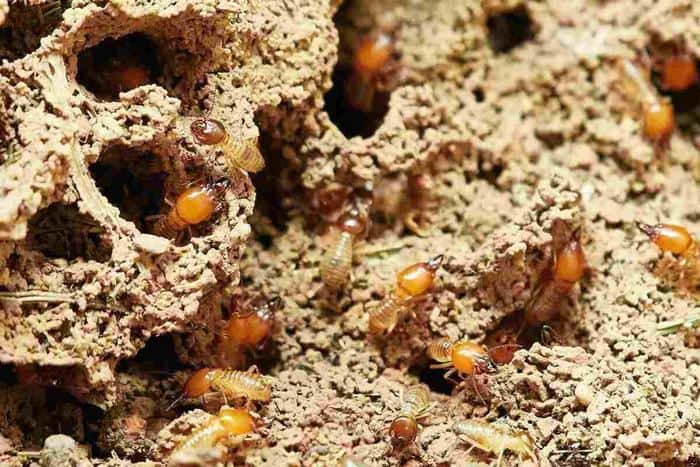The idea of termites infesting your home can be scary. Knowing all the destruction of these pests will make you even more nervous. Initially, it is just a concern.
There was nothing to indicate the presence of termites. However, when the worry becomes an actual alarm, things can become quite distressing.
What if you see organisms crawling or flying in your backyard? You unleash your inner pest inspector, and you find tiny holes.
- What Would Termite Holes Look Like?
- How To Identify Termites Outside?
- Identifying Termites In Grass
- Features of Termites
- How To Tell If It’s A Termite Or Ant
- Different Types Of Termites
- Should Termites In The Garden Cause Alarm?
- What Is The Impact Of This Phenomenon?
- Indicators Of Termite Infestation
- What Do Termite Holes In The Ground Look Like?
- PROFESSIONAL PEST CONTROL SERVICE
You are confident that you see termites too. The panic kicks in. But then again, were they truly termite exit holes?
Stay calm and examine the situation. You are now puzzled with a series of questions:
- If there are signs of termites on your porch, is the entire household affected?
- Should the termite problems be a cause for alarm?
- Have the pests caused significant damage to your home?
- What signs of termite infestation should you search for?
Well, local pest control experts encounter such questions and more. It’s understandable if you find the whole situation overwhelming. Many homeowners do. What step should you take next?
What would termite holes look like?
If you suspect an infestation, it would be best to find a solution immediately. What if the sign of termites is evident in your garden? What difference does it make in your approach?
Here is the ideal post that will help you answer these types of questions.
How to Identify Termites Outside?
If you poke around your home and spot holes outside, you might suspect termites. One of the most crucial steps is determining whether they are these destructive pests. It could potentially also be some type of insect.
Identifying Termites in Grass
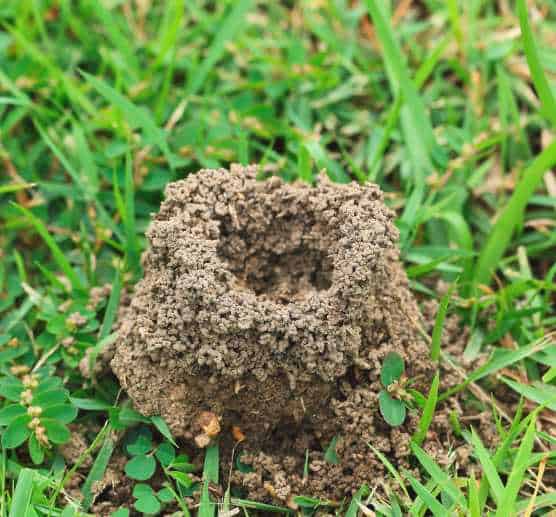
One of the first warning signs of termite activity in the grass is usually a flying swarm. They usually fly around during the warm seasons with much moisture.
Part of the reproducing female and male swarm exit the termite nest. Hence, the primary evidence of termites in your yard will be visible during the humid months every year.
Still, you could see insects with a set of wings and consider them termites when, in reality, they are ants. Confusion is likely to happen. So, what is the difference between termites and ants?
Features of Termites
You can see termites with your naked human eye. They are not microscopic insects. Hence, distinguishing ants and powderpost beetles from termites do not require a magnifying lens.
In addition, it would be best to understand that the dwelling ground of the most destructive termites is underground. Unless you encounter the eastern subterranean termites, they will be nowhere near the surface.
You could potentially find destructive types of termites when you dig below the ground or transfer building material.
Let’s dig deeper into the appearance of termites.
Size
So, you want to know how big or small a termite is-what do you look for?
- Their size ranges from small to medium
- A termite’s body can vary from about 0.75-0.5 inches in length.
Color
How do you tell if it’s a termite based on its color? What shade distinguishes termite wings from other insects?
You can gage the appearance of termites using these details:
- The kind and development stage of the termite that you find will define its color. They vary from white to light brown.
- The color of worker termites is usually a lighter shade than that of termite swarmers which are darkish.
Body
What details do you need to identify a termite based on its body? Let’s take a look here.
- If you see an insect that with pale, stretched-out, and mushy, it could be a termite
- A termite’s figure contains three segments: the head, thorax, and abdomen.
- There are six legs on a termite, with each pair of legs located on each section of the three-segment thorax.
- Their heads contain a pair of antennae about the same length as their heads.
- You will find the mouthpart of a termite on its head.
- You can tell that it is a reproducing male or female if it has a set of termite wings on its thorax.
How to Tell if it’s a Termite or Ant
Occasionally, homeowners come across winged ants and mistake them for termites. It can be difficult to note the difference during your first encounter with either.
However, there are numerous distinguishing features that you can look for.
Their characteristics differ from those of wood-boring insects and carpenter ants. Termites have unique behaviors.
So, what makes winged termites distinct?
- The set of wings on termites is the same length. The waist and antennae are straight.
- The wings of flying ants vary in size. They also have a crooked antennae and a compressed waist.
- While winged ants have a brownish shade in their wings, termites have clear-colored wings.
- The metamorphic growth of an ant takes all four stages. They lay eggs that spawn into larvae. The larva-pupa development stage then comes, transforming into the adult ant.
- The metamorphic process of adult termites is usually incomplete, with only three stages. Adult termites develop from nymphs, which form when an adult hatches eggs. Thus, their development process revolves around adults laying eggs that spawn into nymph termites and then into adults.
- Male ants do not survive after the mating process-they die.
- However, the life of termites, whether male or female, does not end with mating.
Different Types of Termites
Up until today, there have been above three thousand different termite species. Yet, North America can only identify 20 of them as pests. If you own a home in the United States, you may have to experience and control different termite species:
- Dampwood termites
- Drywood termites
- Subterranean termites
Dampwood Termites
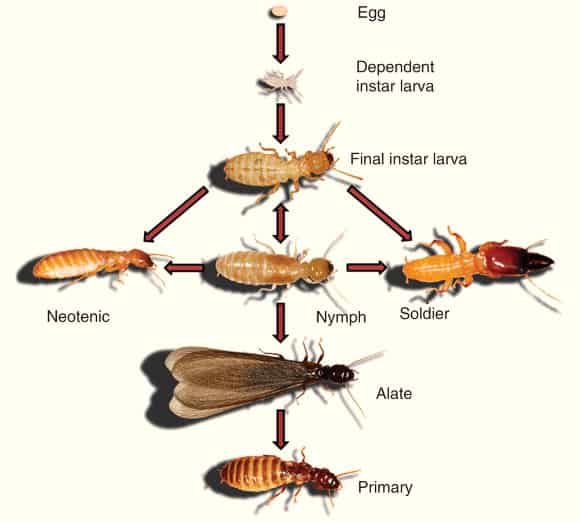
The damp wood termites are the biggest ones that you will see. If you live in the Pacific coastal regions, desert, or semi-arid surroundings, you have probably come across the termite species.
Dampwood termites are common in the southern and Southwestern regions of Florida.
They do well in increasingly moist areas, as you can deduct from their names. So, damp wood termites invading your home’s foundation is unlikely.
Subterranean Termites
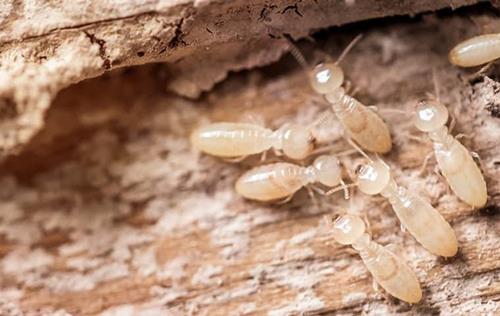
The subterranean species is the most destructive kind. They are the most common termites. So, you can also find them in any part of the country.
Subterranean termites can aggressively invade your home and cause structural damage to your biggest investment. People sometimes refer to destructive Formosan termites as super-termites.
They can damage any structure of your home. Forman termites can chew through floors regardless of your different wood preferences.
Drywood Termites
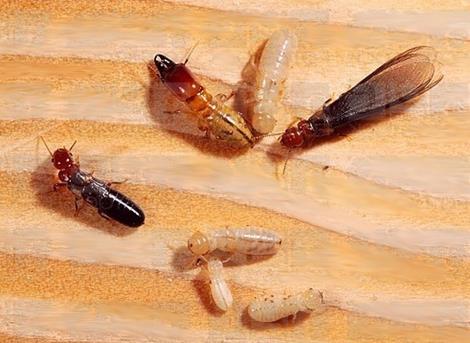
If you are a resident of Southern California, dry wood termites are the most common pests.
The pests can damage wood structures like door frames and progress to the interior walls of the building. They can also pose a threat to your flooring and home fixtures.
Should Termites in the Garden Cause Alarm?
Are you a southern homeowner who fancies gardening? You must have come across termites when preparing your garden for planting season. You can even come across pests nibbling on the ground at night.
Termites are a crucial part of the ecosystem. They decompose deadwood. When these organisms recycle dead trees in your yard, they create an essential balance in the ecosystem.
They become a nuisance when they build a termite nest near your home or commercial building.
A professional pest control company can verify the tremendous effects of termite infestation. They can bring down your biggest investment without your knowledge.
So, if there are signs of termites on your property, should you make a fuss out of them?
Termites could be foraging in your yard since their natural food source is a specific plant material in your backyard. The organisms could only be feeding on the tree stumps, leaves, or herbivore fecal matter.
The creatures progress to another place when they deplete the food source close to their termite colony.
Sometimes, they find dead trees, wood, or an entirely new colony. Thus, the basic need for food can drive termites into your home.
The presence of wood on your property will result in termites creating mud tubes. You end up with shelter tubes leading to your home.
What is the impact of this phenomenon?
- You may begin to see the signs of termite damage to your home structures. The situation becomes even more alarming when you have a wooden house or floors.
- Your residential property may lack a wooden exterior. However, significant damage can occur to the walls and the home’s foundation.
- If they infest your house, they become a threat to your fixtures, ceilings, and cabinets.
- All cellulose-based resources like mats, clothes, books, and picture frames face the risk of infestation.
- Termites are around-the-clock feeders. So, if the mud tunnels from a termite colony lead to your home, their impact can rapidly progress.
Indicators of Termite Infestation
Termite infestation can manifest in the following ways:
Mud Tubes
Termites create small tubes with mud or dirt. The tunnels create the impression of filled strands.
They can be in crawl spaces, your backyard, or form on the wooden handles of wooden household products. The tubes have active termites leading from their termite colonies to your home.
Flying Termites
Termite swarmers are the most common evidence of infestation on your lawn.
When the flying termites exit their little holes and land on the ground, they leave behind wing remnants.
You can see uniformly shaped wings with identical color and size anywhere on the ground and know about termite infestation.
Holes in Wood
Termites munch on wood from the inside out. If you find tiny holes that lead to tunnels, it is a warning sign of termite galleries.
Also, tapping on the damaged wood surface produces a hollow sound.
Termite Droppings
A dry wood termite swarm releases brownish fecal pellets that look like coffee grounds. Just poke around infested surfaces, and you will find termite droppings.
Stuck Windows and Doors
Live termites excrete and leave mud from their kick-out holes. The dirt attracts moisture. Extreme situations result in moist wood swelling, thus becoming difficult to close or open.
How to Eliminate Termites
Now that you know the warning signs, you can conduct a vision termite inspection.
If a termite colony is feeding on a tree stump nearby, clearing the area is recommendable. If you eliminate the food source, the pests will have to find a new colony elsewhere.
Applying termite treatment to infested areas is also crucial. The best way to eliminate pests is to call a professional.
What Do Termite Holes in The Ground Look Like?
Some people can mistake other wood-boring ants and insects such as carpenter bees for termites.
However, termites have unique features. They have brownish three-segment bodies and a pair of legs on each segment.
Termites like to invade wooden surfaces and, sometimes, holes. On the ground, they build mud tubes that look like filled strands.
The flying swarmers have identical white wings with equal length. They are the first visible sign of infestation.
The best way to conduct termite inspection and treatment is with the help of an expert pest control professional.
PROFESSIONAL PEST CONTROL SERVICE

OR
FILL OUT THE FORM BELOW TO GET A FREE QUOTE
Termite Related Posts
- How Easily do Termites Spread from Wall to Furniture
- What Do Termites Sound Like? (Listen)
- What Do Termite Eggs Look Like?

